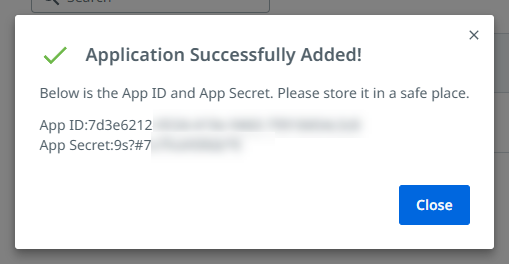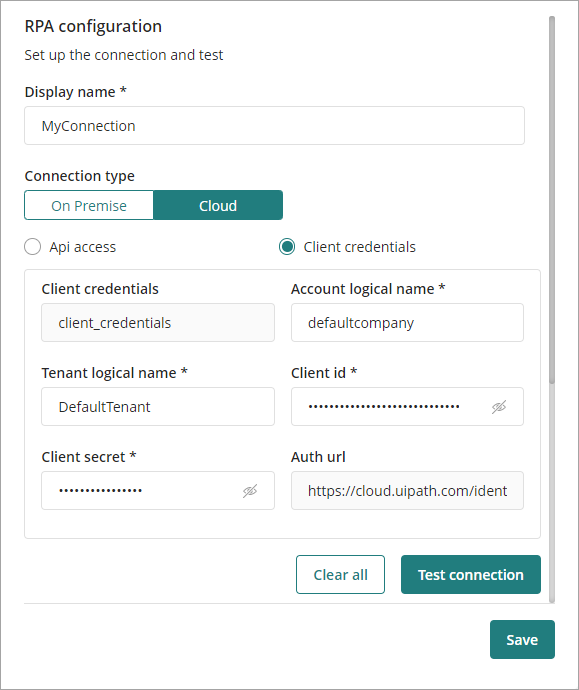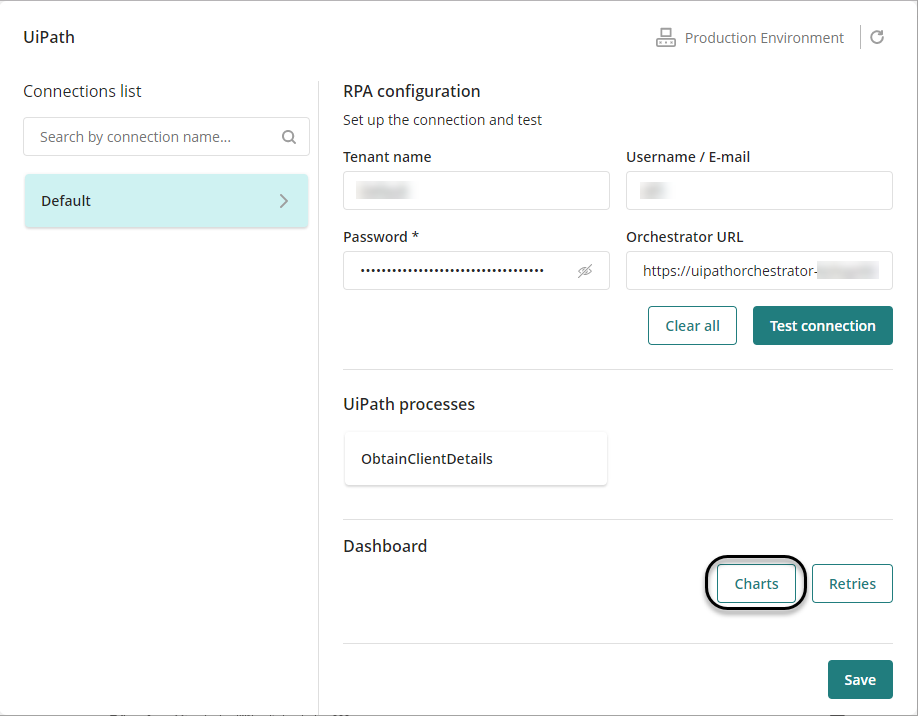Overview
From the Management Console, you can view your configured bot processes and modify the connection to your UiPath Orchestrator of your environment. Additionally, you can access your Orchestrator dashboard, where you can monitor it by using charts or retry your failed jobs.
View current configuration
Go to the RPA Bots section and select the UiPath option.

On the center panel you can see the available connections.

When you select one the window will now have the following sections:

1.RPA configuration: In this section you can see and modify your Orchestrator connection
2.UiPath processes: In this section you can see the name of all your configured UiPath processes that use this connection.
3.Dashboard: You can access the two sections of the RPA Dashboard: Charts and Retries.
Configure connection
In the section called RPA configuration you can change your connection configuration. Note that you are able to configure an on-premise connection, where you will be responsible for managing all the infrastructure for your resources to work or a cloud connection, where UiPath manages all the infrastructure for your resources to work.
Note that you are able to configure an on-premise connection, where you will be responsible for managing all the infrastructure for your resources to work or a cloud connection, where UiPath manages all the infrastructure for your resources to work.
On-Premise Connection
The following list explains all the parameters that need to be configured in order to configure a successful on-premise connection to your orchestrator, which hosts the process you want to trigger from Bizagi.
•Tenant Name: name of the orchestrator instance you provided at the time of its creation.
•Username / Email: associated Username or Email of an admin user of the orchestrator.
•Password: corresponding password to the previous field.
•Orchestrator URL: URL of the UiPath orchestrator. Usually the value that must be inputted in this field is https://platform.uipath.com/.
Fill the required fields and click test connection.

If you get the following message:

Save your changes.

Once you are finished filling up the form fields, click Test connection and check that the resulting connection status on the text field below, shows a message indicating a successful connection.

If a message indicating otherwise is shown, review the inputted information and try again. Once your connection is successful, click OK.
|
You can configure a different connection for each of your Environments by creating a new configuration in their respective tab. You can change these connections for your Test or Production environment from the Management Console. |
Cloud Connection
When configuring a cloud connection there are two authentication options: Client credentials or API Access.
Client credentials authentication (OAuth)
Before configuring the connection within Bizagi, it is necessary to register Bizagi as an application in the UiPath cloud console settings. To do this, within your cloud console go to the admin section, select the External Applications option and click the Add Application button.

Name the Application. Select the application type, we recommend always choosing Confidential application for security measures. In the resources section, add the Orchestrator API Access and select the desired scopes. The minimum scopes are OR.Execution, OR.Folders.Read, OR.Jobs, OR.Queues and OR.Robots.Read for both user and application for the integration with Bizagi to work. Lastly, the configuration requires a URL for the authentication response, Bizagi does not require a specific URL so it can be any address for example your Localhost.

When you finished entering all the required parameters click the Add button, with this the App Id and App secret are created, these are the parameter needed to configure the cloud connection in Bizagi.

Once registered the new application and obtained the client credentials within UiPath it is time to configure the cloud connection in Bizagi. To do so, head to the UiPath RPA configuration wizard (either in the management console or within Studio) and enter the parameters required:
•Account Logical Name: logical name found within the portal's URL. For example, if your URL is https://cloud.uipath.com/defaultcompany, the account logical name is defaultcompany.
•Tenant Logical Name: logical name of the selected service. Take into account that it may differ from the tenant's name. For example, if the tenant's name is default, the tenant's logical name may be defaulthr8139.
•Client id: id of the application registered in the UiPath cloud console.
•Client secret: secret generated when registering the application in the UiPath cloud console.

Once you are finished filling up the form fields, click Test connection and check that the connection status is successful.

API Access authentication
The following list explains all the parameters that need to be configured in order to configure a successful cloud connection to your orchestrator via API Access, which hosts the process you want to trigger from Bizagi.
The following list explains all the parameters that need to be configured in order to configure a successful cloud connection to your orchestrator, which hosts the process you want to trigger from Bizagi.
•User key: allows you to generate unique login keys to be used with APIs or with 3rd party applications in order to log in and perform actions on your behalf.
•Account Logical Name: logical name found within the portal's URL. For example, if your URL is https://cloud.uipath.com/yourSite, the account logical name is yourSite.
•Tenant Logical Name: logical name of the selected service. Take into account that it may differ from the tenant's name. For example, if the tenant's name default, the tenant's logical name may be defaulthr8139.
•Client ID: ID specific to the Orchestrator itself. It is the same for all users and tenants on a specific platform.
You may get the values for these parameters in the UiPath Automation Cloud portal. To do so, go to the Admin option and under your tenant's name, click API Access.

Once you are finished filling up the form fields, click Test connection and check that the resulting connection status on the text field below. It should show a message indicating a successful connection.

If you get the following message:

Save your changes.

If a message indicating otherwise is shown, review the inputted information and try again. Once your connection is successful, click OK.
In this section you can view a report of your Orchestrator's Jobs and Queue Items in chart form.

To access this section go to the Chart button under the RPA Dashboard section. You must wait a few seconds until the report loads.

You can see three pie charts showing the status of all jobs executed in the last 24 hours, 7 days, and 30 days. Additionally, a 2-D line graph shows the number of executions by status each month of the last year.

You can remove a status from your graph by clicking the label showing the status name. The Dashboard will cross-out the excluded status label.

You can view a similar report for your Queueitems by clicking on the Queueitmes button.

If there is no data to display a blank chart is shown.
In this section you can view the failed Orchestrator Jobs and Queueitems and retry them directly from the Management Console.

To access this section go to the Chart button under the RPA Dashboard section. You must wait a few seconds until the report loads.

You can retry your failed jobs by clicking the ![]() icon. You can retry your failed jobs by clicking the icon. The Management Console creates a new instance of the job. Since this is a different instance, the failed job will still be visible in the list.
icon. You can retry your failed jobs by clicking the icon. The Management Console creates a new instance of the job. Since this is a different instance, the failed job will still be visible in the list.

A new panel appears showing additional information about the job.

Click Yes, retry job and wait until the following message appears.

You can view a similar window for your Queueitems by clicking on the Queueitmes button.

Last Updated 3/29/2023 9:21:15 AM